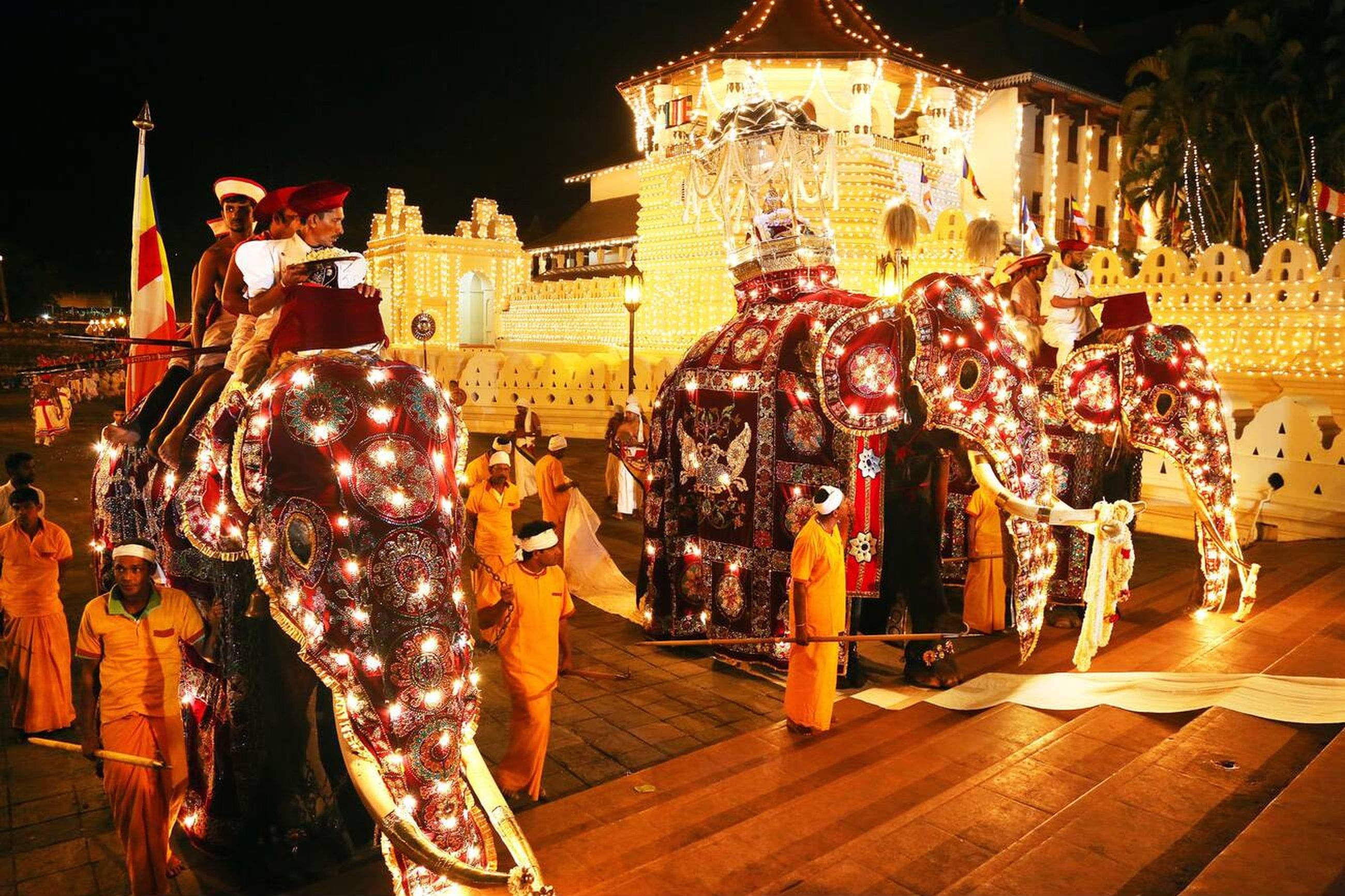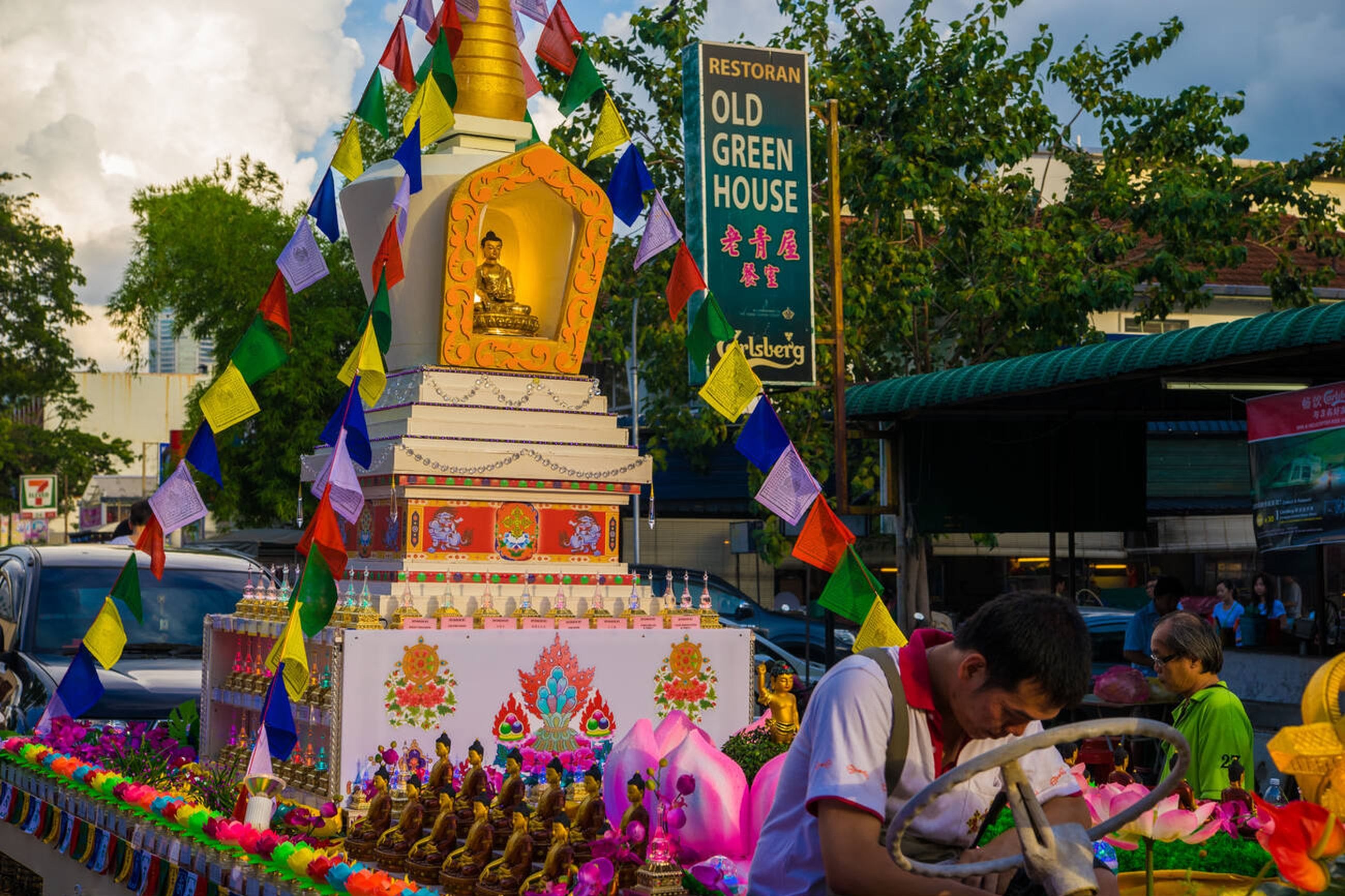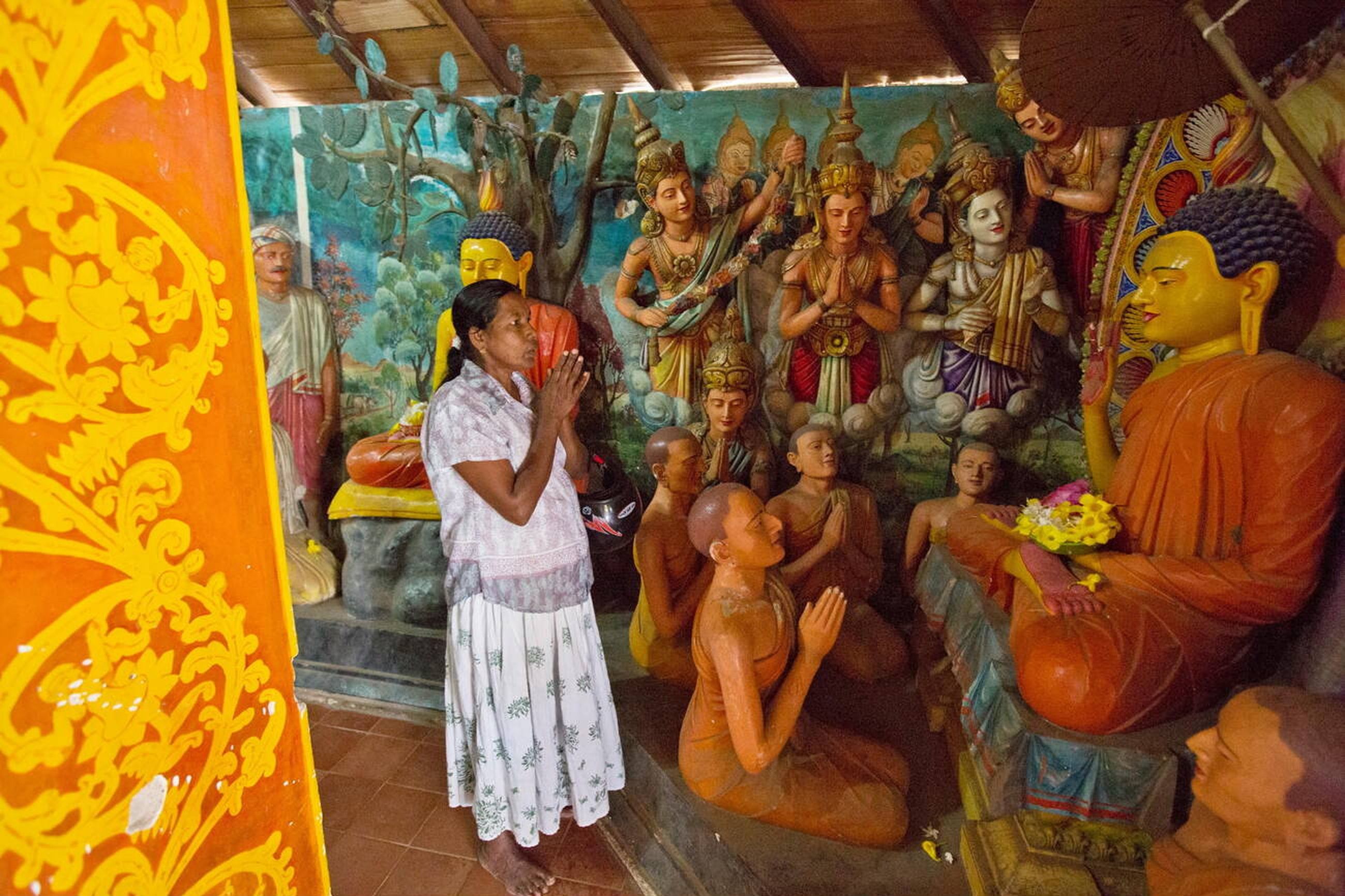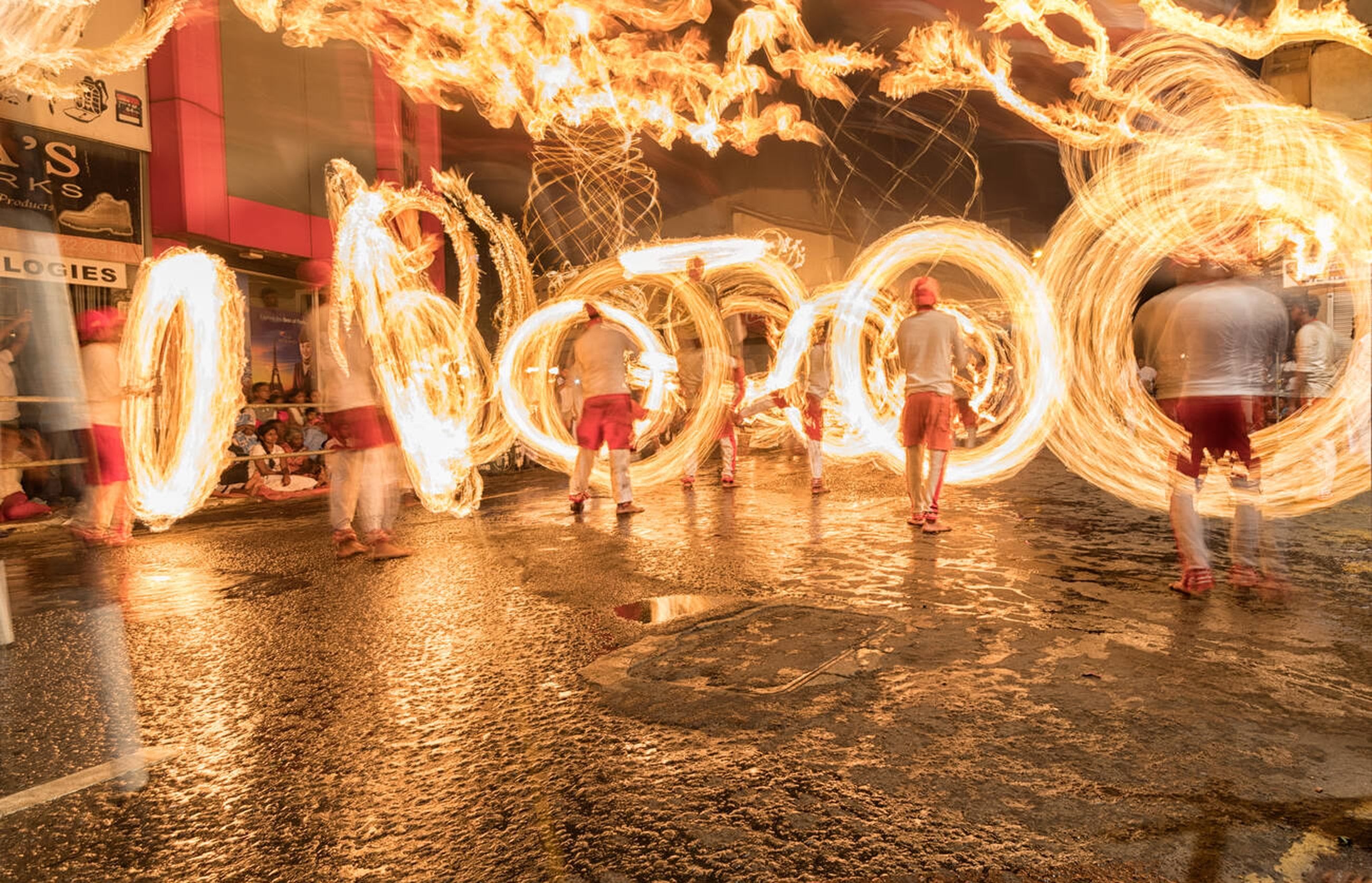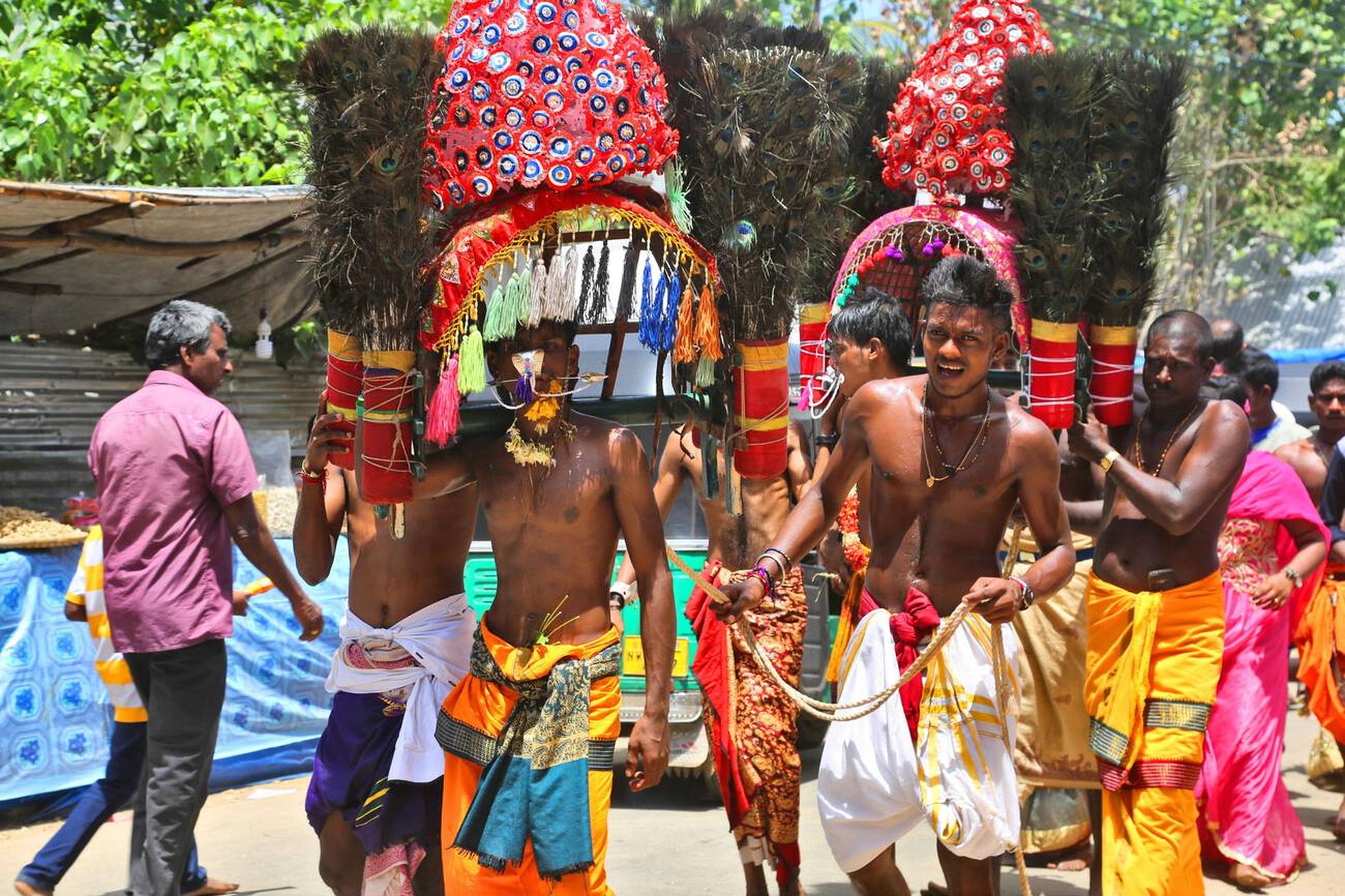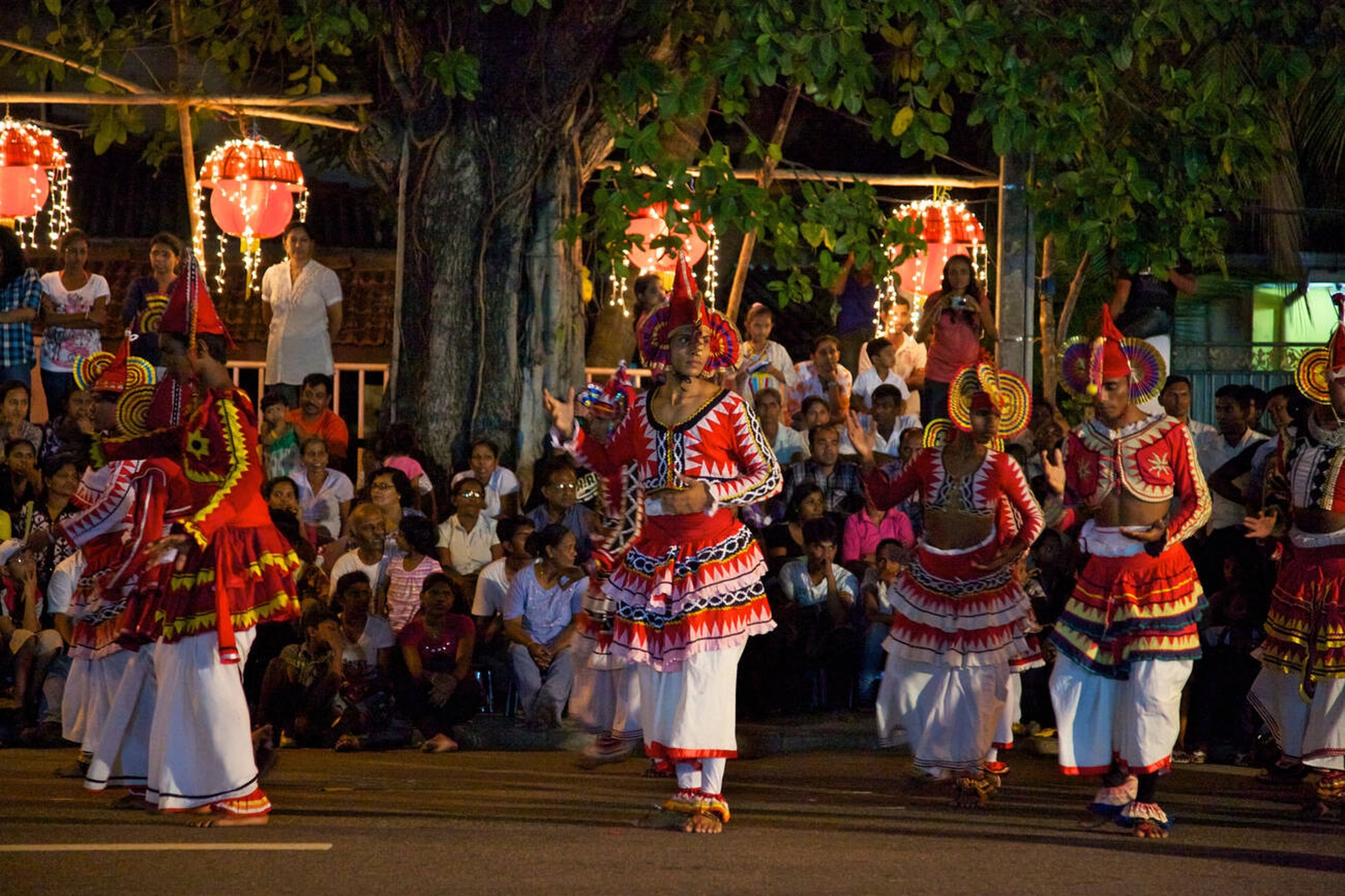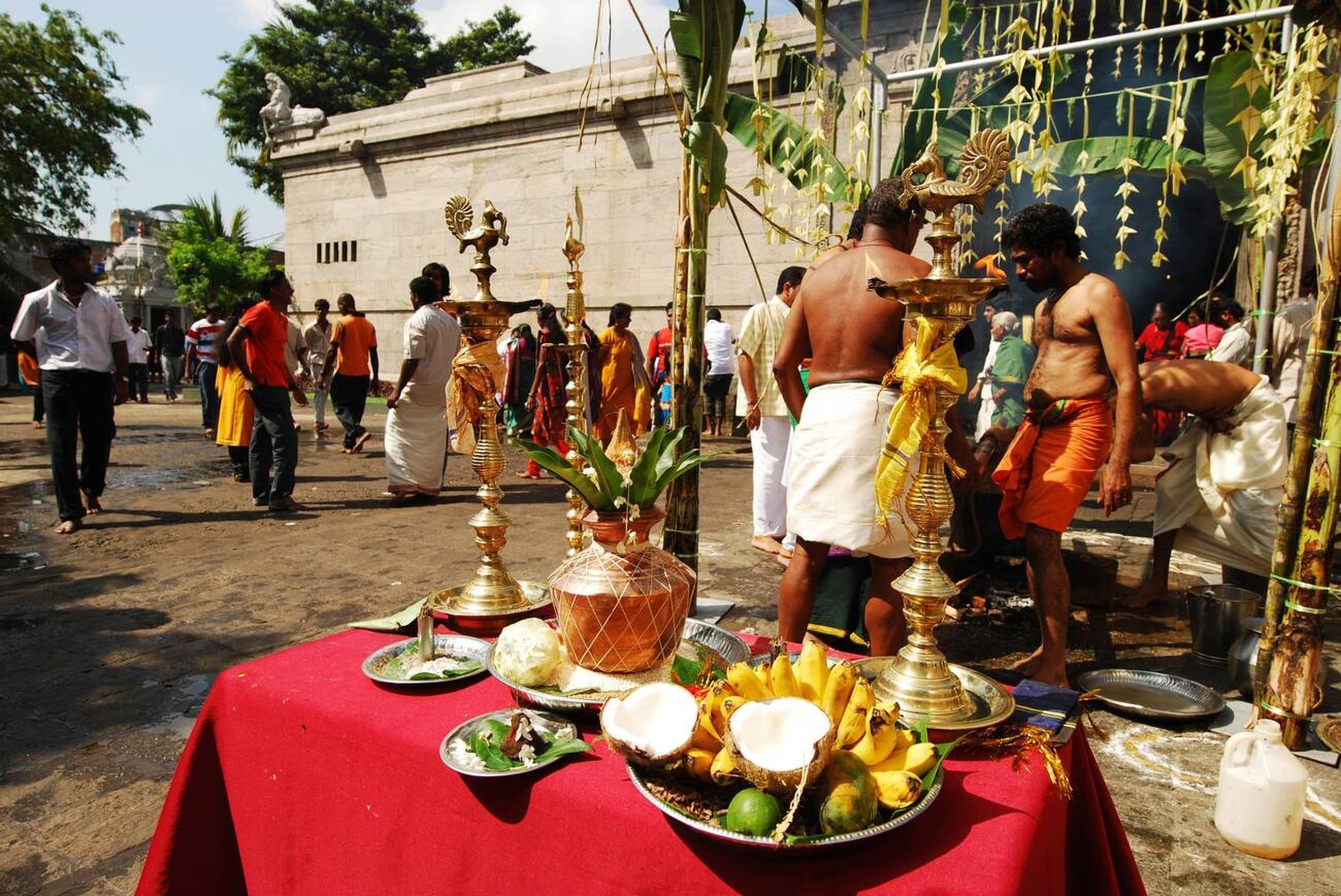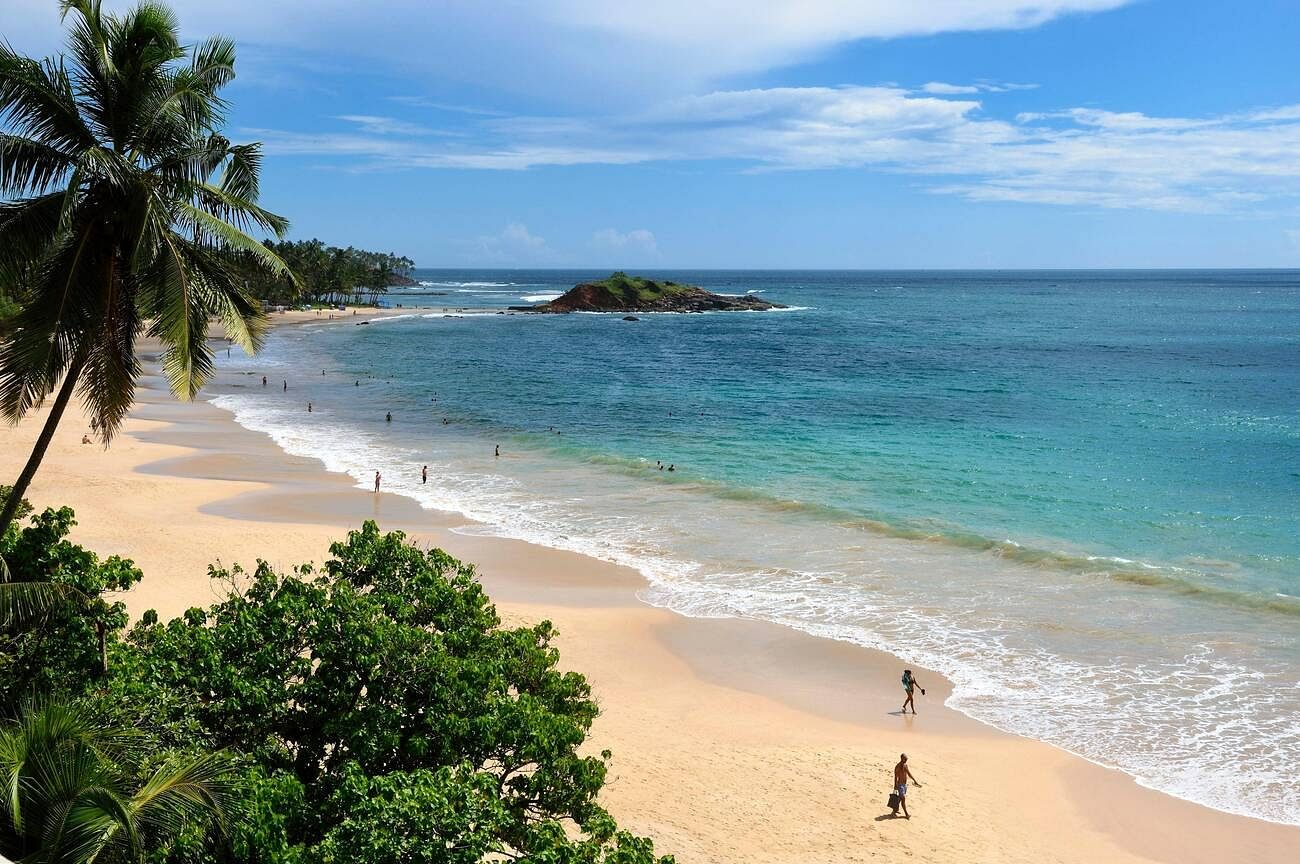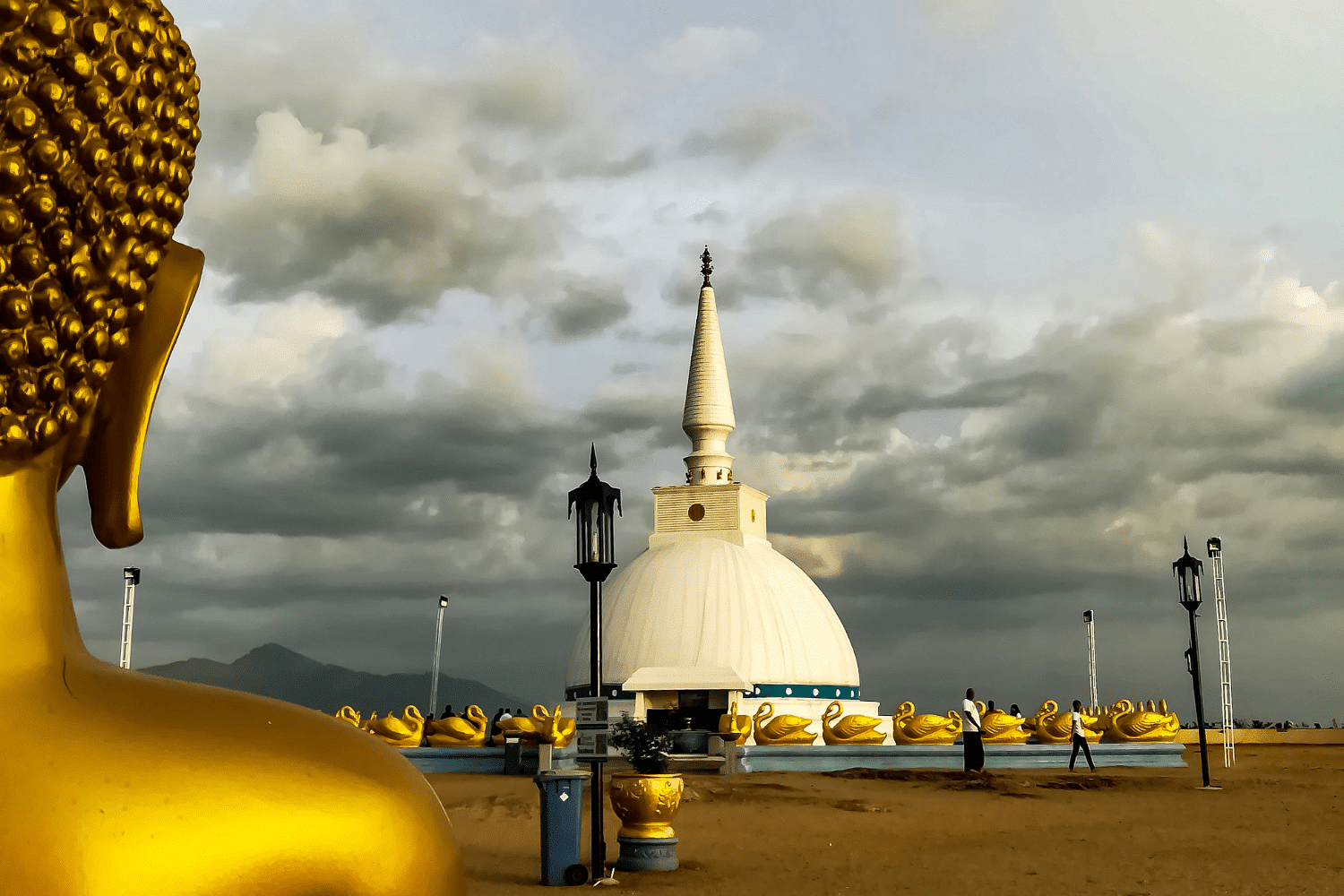Festivals in Sri Lanka are pure energy - lanterns glow, drums roll and streets come alive. This simple guide helps you plan your trip around the island’s biggest celebrations, from Buddhist pageants to Hindu festivals in Sri Lanka like Thai Pongal, Maha Shivratri and Deepavali.
We’ll show you the can’t-miss moments - Vesak’s sea of lights and the Kandy Esala Perahera, often called the most famous festival in Sri Lanka. You’ll learn when to go, what to wear and how to join respectfully, with easy tips for first-time visitors.
Want a smooth, stress-free plan? Check out curated Sri Lanka tour packages that line up transport, guides and great viewing spots - so you can enjoy the show. Ready to see the brightest festivals in Sri Lanka? Let’s start your festival-filled itinerary now.
11 Famous Festivals in Sri Lanka
- Sinhala and Tamil New Year
- Vesak
- Poson Paya
- Kandy Esala Perahera
- Kataragama Esala Festival
- Nallur Kandaswamy Temple Festival
- Duruthu Perahera
- Navam Perahera
- Maha Shivratri
- Thai Pongal
- Deepavali
1. Sinhala and Tamil New Year
Sinhala and Tamil New Year (Avurudu/Puthandu) is one of the most vibrant festivals in Sri Lanka, celebrated as the island’s joyful spring reset, usually on April 13–14. Families pause during the quiet nongathaya, then light the hearth at auspicious times, cook kiribath (milk rice), share sweetmeats like kavum and kokis, exchange gifts, and visit elders. Villages burst into friendly games, drumming, and laughter, while temples host blessings and oil-anointing rituals for health and prosperity.
- When: April 13-14
- Key rituals: Nonagathaya pause, lighting the hearth, first meal (kiribath), first transaction, herbal oil anointing, visiting elders.
- Food to try: Kiribath, kavum, kokis, aggala, aluwa, and seasonal fruits.
- Where to experience: Community fairs in Colombo/Kandy; lively village games in the South and hill country; temple-focused Puthandu events in Jaffna and the North/East.
- Etiquette: Dress modestly, remove shoes/hats in temples, ask before photos, accept food with your right hand.
- Practical tips: Book transport/hotels early, carry some cash, plan a slower pace, and stay in one town to join local events.
best-selling sri lanka tour packages
Vesak is among the most luminous Buddhist festivals in Sri Lanka, marking the Buddha’s birth, enlightenment, and passing. It usually falls on the May full moon and turns towns into seas of light - paper lanterns, giant pandols and dansalas line the streets. Temples fill with devotees observing sil, offering flowers and listening to sermons, while families decorate homes and hang lanterns at their gates. For visitors, Vesak is both peaceful and festive where you can admire the lights, try free refreshments and watch cultural shows.
- When: May full moon
- Key rituals: Observing sil at temples, offering flowers and oil lamps, listening to sermons, creating and displaying lanterns, visiting pandol installations and engaging in charity via dansalas.
- Food to try: Free dansala offerings like tea, ice cream, rice and curry, noodles
- Where to experience: Colombo, Kandy, Galle and hthe ancient cities of Anuradhapura and Polonnaruwa for temple-focused ambience.
- Etiquette: Dress modestly, remove shoes and hats in temple areas, keep voices low, avoid flash photography during prayers and accept food politely.
- Practical tips: Go just after sunset for the best glow, expect crowds and traffic near displays, carry small cash for transport, bring water and allow time to wander from lantern streets to nearby temples.
Poson Paya marks the arrival of Buddhism in Sri Lanka - when Arahant Mahinda met King Devanampiya Tissa at Mihintale in the 3rd century BCE. The island turns serene and devotional, pilgrims in white visit temples, chant and share freely at dansalas. Towns display lanterns and story panels, but the heart of Poson is quiet reflection and country-wide pilgrimage.
- When: June full moon
- Key rituals: Observing sils, pilgrimages to Mihintale and Anuradhapura, almsgiving and dansalas, all-night chanting and sermons, lighting oil lamps and temple offerings of flowers and incense.
- Food to try: Free dansala fare - tea, herbal drinks, rice and curry, noodles, kola-kendaa plus seasonal sweets.
- Where to experience: Mihintale, Anuradhapura, Thanthirimale, Damulla/Matale region and city displays in Colombo and Kandy.
- Etiquette: Wear white or modest clothing (cover shoulders/knees), remove shoes and hats at temples, keep voices low, avoid flash photography, queue patiently at shrines and dansalas, and accept offerings with your right hand.
- Practical tips: Book stays/transport early, expect heavy crowds on pilgrimage routes, bring water and a light shawl, go at dawn or after sunset for cooler climbs and the best atmosphere, and carry a small torch for temple paths at night.
Kandy Esala Perahera is Sri Lanka’s most grand and world-famous festival - a spectacular blend of devotion, dance, and dazzling pageantry. It honors the Sacred Tooth Relic of the Buddha, housed in Kandy’s Temple of the Tooth. For ten magical nights, the city becomes a living stage with fire dancers, whip-crackers, drummers and majestic elephants parading through the streets under torchlight, making it one of the grandest festivals in Sri Lanka.
- When: Usually held late JUly to Early August, depending on the lunar calendar.
- Key rituals: Daily peraheras featuring temple dignitaries, drummers, dancers and elephants. Kap Situweema marks the start, nightly parades grow largest and the final day ends with the Day Perahera and water-cutting ceremony at the Mahaweli river.
- Food to try: Street vendors offer kottu roti, hoppers, curd with treacle, and sweet treats like kokis and aluwa. During festival nights, locals also set up small stalls with drinks and snacks for visitors.
- Where to experience: The heart of it is Kandy city, especially near Temple of the Tooth, Dalada Veediya, and Queen’s Hotel. Book seats or balconies along the procession route for clear views. Some hotels offer festival-viewing packages.
- Etiquette: Dress modestly (shoulders/knees covered), stay quiet during blessings, avoid flash photography, and never stand higher than the Sacred Tooth Relic casket. Respect temple boundaries and the monks’ space.
- Practical tips:
- Book accommodation early. Kandy fills up months ahead.
- Arrive by afternoon to find a good viewing spot.
- Expect heavy crowds and restricted vehicle movement, walk or use tuk-tuks.
- Carry water, snacks, and a small torch for returning after dark.
- Join locals in lighting lamps or offering flowers at the temple during the day.
5. Kataragama Esala Festival
Kataragama Esala Festival is a powerful, multi-faith pilgrimage in Sri Lanka’s deep south, honoring Skanda/Murugan. For several nights the town pulses with drumming, kavadi dances, vows and torchlit processions from the Kataragama Devalaya to the Menik Ganga. Hindu, Buddhist, and indigenous Veddah traditions meet here - intense, devotional and unforgettable.
- When: Late July-early August
- Key rituals: Kavadi dances and vow fulfillment (sometimes with body piercing), fire-walking, breaking coconuts, fruit offerings, the Pada Yatra foot pilgrimage arriving from the north/east coasts, temple peraheras (processions), and a concluding water-cutting rite at the Menik Ganga.
- Food to try: Free dansala offerings (tea, drinks, simple meals) plus local staples, kottu roti, hoppers, string hoppers, curd with treacle, seasonal fruits and sweetmeats near the temple streets.
- Where to experience: Kataragama town and the Devalaya complex, riverbank of Menik Ganga, and nearby Sella Kataragama (4 km) for quieter worship. Many stay in Tissamaharama for better lodging and travel in each evening.
- Etiquette: Dress modestly (shoulders/knees covered), remove shoes/hats in sacred areas, don’t obstruct processions, avoid flash/close-up photos of vow rituals, keep alcohol and loud behavior away from the precincts, and give devotees space—do not touch kavadi bearers or fire-walkers.
- Practical tips: Book early (rooms sell out), arrive by late afternoon to secure a viewing spot, expect road closures and big crowds, carry water and insect repellent (hot, humid nights), use cash for small purchases, bring a small torch for dark paths, and follow police/temple stewards for safe vantage points along the route.
6. Nallur Kandaswamy Temple Festival
Nallur Kandaswamy Temple Festival is one of the grandest Hindu festivals in Sri Lanka, celebrated with devotion and color in Jaffna. Dedicated to Lord Murugan (Skanda), it transforms the Nallur area into a vibrant spiritual center for nearly a month. The festival blends tradition, music, and pageantry, drawing devotees and visitors from across the island and abroad.
- When: Usually held from late July to early September, lasting about 25–28 days. The exact dates vary each year based on the Tamil calendar.
- Key rituals: Daily poojas and processions with temple chariots, kavadi dancers carrying offerings and skewered with small spears, theertham (water-cutting) ceremony at the temple tank; and the grand Ther Thiruvila (Chariot Festival)-the highlight where the deity is paraded on a massive wooden chariot pulled by hundreds of devotees.
- Food to try: Temple prasadam, dosai, vadai, idli, and sweets like laddu, jalebi and milk toffee.
- Where to experience: The Nallur Kandaswamy Kovil in Jaffna town, the heart of the festival. The surrounding streets fill with processions, music, and crowds. You can also explore nearby Nainativu Nagapooshani Amman Temple for another Murugan-related pilgrimage.
- Etiquette: Dress modestly, remove shoes before entering temple grounds, cover shoulders and knees and avoid photography during prayers.
- Practical tips: Book accommodation early, Jaffna gets busy during festival weeks. Visit early morning or evening to avoid heat and crowds. Bring water, cash for offerings, and patience for long processions. Respect temple boundaries and follow stewards’ directions. For the Chariot Festival, arrive before sunrise to secure a good spot along the route.
Suggested read: Hotels in Sri Lanka
Duruthu Perahera is a luminous New Year season pageant held at Kelaniya Raja Maha Vihara near Colombo, honoring the Buddha’s first legendary visit to the island. With drummers, dancers, whip-crackers and caparisoned elephants, it’s one of the most photogenic buddhist festivals in Sri Lanka, blending devotion with dazzling night-time spectacle.
- When: January
- Key rituals: Temple poojas and blessings, nightly processions featuring low-country, Kandyan and Sabaragamuwa dance troupes, traditional drumming and the casket carrying sacred relics.
- Food to try: Hoppers, kotu, short eats, kokis, aluwa and milk toffee.
- Where to experience: Kelaniya town, especially the precincts of Kelaniya Temple.
- Etiquette: Dress modestly (shoulders/knees covered); remove shoes and hats in temple areas; keep voices low; avoid flash during blessings; don’t push through lines, wait for stewards’ guidance.
- Practical tips: Arrive by late afternoon to secure a viewing spot; expect road closures and heavy crowds, walk when possible; carry water and a small torch for the return; have cash for snacks and transport; book Colombo lodging early if you plan to watch all three nights.
Navam Perahera is Colombo’s signature night-time procession, staged by Gangaramaya Temple. It blends drummers, dancers, whip-crackers, and caparisoned elephants with the city’s modern skyline, an unforgettable contrast. As one of the most accessible religious festivals, this dazzling festival of Sri Lanka attracts both locals and travelers. It offers visitors a chance to witness centuries old Buddhist pageantry unfold right in the heart of capital.
- When: February
- Key rituals: Tbstandard-bearers carrying historic flags; and a casket borne in honor of sacred relics.
- Food to try: Colombo street stapes - hoppers, egg hoppers, kottu roti, isso wade, curd with treacle and festive-time sweets like kokis and aluwa.
- Where to experience: Around Gangaramaya Temple and Beira Lake; viewing spots along Perahera Mawatha, Sri Jinarathana Road, and nearby boulevards. Many hotels and offices offer balcony vantage points, book ahead.
- Etiquette: Dress modestly (cover shoulders/knees); remove shoes/hats in temple areas; avoid flash photography during blessings; don’t step onto the route or block performers; follow directions from stewards and police.
- Practical tips: Arrive by late afternoon to secure a curbside spot; expect road closures and heavy traffic, use tuk-tuks or walk, carry water and small cash for snacks/transport, plan your return route before the parade begins; if you want photos, position near well-lit corners and keep a respectful distance.
Maha Shivratri is one of the most significant religious festivals in Sri Lanka, celebrated mainly by the island’s Hindu communities. Dedicated to Lord Shiva, it symbolizes the triumph of light over darkness and ignorance. On this sacred night, temples glow with lamps and chants, as devotees fast, offer prayers and stay awake through the night in meditation and devotion.
- When: February or March
- Key rituals: Devotees observe fasting, perform Abhishekam (ritual bathing of the Shiva Lingam with milk, honey, and water), decorate temples with flowers and lights, and chant hymns like Om Namah Shivaya. Many stay awake all night, engaging in prayer, bhajans, and temple activities.
- Food to try: Milk, fruits, jaggery and coconut
- Where to experience: Major celebrations take place in Koneswaram Temple (Trincomalee), Munneswaram Temple (Chilaw), Colombo’s Sri Kailawasanathan Swami Devasthanam, and Ponnambalawaneswaram Temple. Northern and Eastern provinces—especially Jaffna—host the most vibrant observances
- Etiquette: Dress modestly (white or light colors preferred), remove shoes before entering temples, avoid taking photos during pujas, and maintain silence during prayers. If you’re visiting a temple, it’s respectful to offer flowers or fruits.
- Practical tips: Visit temples in the evening or at midnight, when prayers peak; carry offerings if joining locals; expect crowds in major temples, arrive early; and plan transport ahead, as some towns hold processions.
Suggested read: Nuwara Eliya tourist attractions
Thai Pongal is a joyful Tamil harvest festival and one of the warm, community-centered religious festivals in Sri Lanka. Families give thanks for the year’s first rice, honor the sun (Surya), and share sweet pongal cooked at dawn, homes fill with kolam (rice-flour art), music, and the smell of jaggery and cardamom.
- When: January 14 each year
- Key rituals: Dawn pongal cooking in a new clay pot facing east; letting the milk boil over for good fortune; offering the first rice to Surya; decorating entrances with kolam; family prayers at temples and at home; visits to elders and neighbors.
- Food to try: Sweet pongal (rice, milk, jaggery, ghee, cardamom), sakkarai pongal, ven pongal (savory), vadai, dosai, coconut sweets, bananas, and seasonal sugarcane.
- Where to experience: Tamil neighborhoods and temples in Jaffna, Trincomalee, Batticaloa, Mannar, and parts of Colombo (Wellawatte, Kotahena). Morning temple visits followed by family gatherings are the heart of the day.
- Etiquette: Dress modestly (light colors are common), remove shoes in temples, ask before photographing home rituals, accept food with your right hand, and be mindful around hot clay pots.
- Practical tips: Go early morning to see the pongal boil-over; bring small fruit/flower offerings for temples; expect quieter streets and family time rather than big parades; carry cash for local sweets; if invited, bring a simple gift (fruit or sweets) and enjoy the hospitality.
Deepavali, also known as Diwali, the Festival of Lights, is one of the most joyful and exciting festivals in Sri Lanka. Celebrated mainly by the island’s Tamil Hindu community, it symbolizes the victory of light over darkness and good over evil. Homes and temples glow with oil lamps, fireworks light up the night sky, and families exchange sweets and gifts in a spirit of togetherness and renewal. This radiant festival of Sri Lanka beautifully showcases the island’s cultural diversity and the deep spiritual traditions that unite its people in joy and hope.
- When: October or November
- Key rituals: Early morning oil baths, temple visits, lighting rows of clay lamps (diyas), offering prayers to Goddess Lakshmi, decorating homes with kolam (colored rice patterns), and sharing sweets with family and neighbors.
- Food to try: Delicious Indian and Tamil sweets like laddu, mysore pak, halwa, murukku, and mixture, along with festive meals featuring dosai, vadai, and spiced rice dishes. Many households also prepare homemade milk sweets.
- Where to experience: Tamil-majority regions such as Jaffna, Trincomalee, Batticaloa, and Colombo’s Wellawatte area. Temples like Sri Kailawasanathan Swami Devasthanam and Ponnambalawaneswaram Temple in Colombo are beautifully decorated and open for visitors.
- Etiquette: Dress neatly and modestly (bright or traditional colors are appreciated), remove shoes before entering temples, and accept sweets or gifts with your right hand. Ask politely before taking photos inside homes or temples.
- Practical tips: Visit temples in the evening when the lamps are lit for the most magical atmosphere. Shops may close early, so plan transport and meals in advance. If invited to a home, bring a small box of sweets or fruit as a gesture of goodwill.





